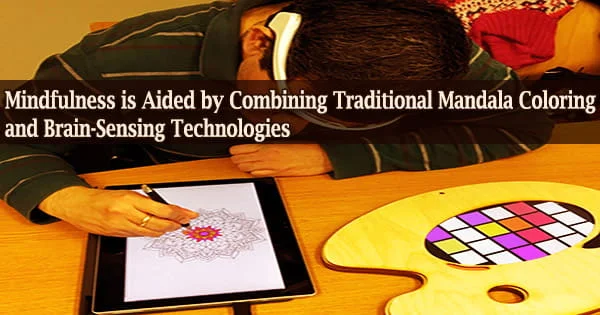Combining centuries-old mandala coloring with cutting-edge computing and brain-sensing technology may lead to new ways of assisting people in achieving mindfulness.
Mandalas are geometric shape arrangements that have their origins in Buddhist traditions. The practice of coloring mandala shapes is becoming increasingly popular as a means for people to practice mindfulness,’ or being present in the moment, which has been linked to improved mental health and wellness.
Lancaster University’s human-computer interaction researchers have created a novel prototype that can monitor people’s brain activity while they color mandalas and provide real-time feedback on a peripheral display to reflect levels of awareness.
The researchers believe that methods like these could be developed to enhance the learning and training of focused attention mindfulness practices, as well as to help people deal with stress, depression, and other affective health conditions.
The researchers interviewed experienced mandala practitioners in the first phase of their study to learn about the unique properties of mandala coloring and how they may be utilized to attain mindfulness, and based the prototype on their findings.
The ‘Anima’ prototype includes a tablet device for users to color mandala forms, a wearable EEG headset that scans users’ brain signals, and a second display in the shape of an artist’s palette that is placed in the user’s peripheral vision.
The EEG headset analyzes users’ brain waves and measures levels of mindfulness as they color a digital mandala on the primary display using a stylus. The readings are then displayed on the peripheral display as new colors, based on four colors chosen by the user at the start, but with modifications in saturation and brightness.
Brighter colors reflected periods when the user lost attention or became distracted, while more subtle colors represented occasions when the user lost focus or became distracted.
Making sense of EEG data and capturing it effectively through design is not a trivial process. It was important that the colors appearing on the peripheral display, which was decoupled from the main screen, were ambiguous and subtle in order to provide the ability for users to openly monitor their mindfulness but not in a way that distracted their attention from the coloring itself.
Professor Corina Sas
Professor Corina Sas of Lancaster University’s School of Computing and Communications led the research, which was financed by AffecTech: Personal Technologies for Affective Health, an Innovative Training Network funded by the European Union’s Horizon2020 People Programme under Marie Sk? odowska-Curie.
Professor Sas said: “Making sense of EEG data and capturing it effectively through design is not a trivial process. It was important that the colors appearing on the peripheral display, which was decoupled from the main screen, were ambiguous and subtle in order to provide the ability for users to openly monitor their mindfulness but not in a way that distracted their attention from the coloring itself.”
The findings show that the mandala has two crucial and hitherto unappreciated functions: collecting emotional memories and reflecting on them. Technology has the potential to assist both of these tasks in ways that paper-based mandalas cannot.
Participants expressed a desire to re-engage with their finished mandala during the reflection stage, and even recolor it in more positive colors after they had reflected and their mental position had changed. This would be made easier by technological advancements.
Dominic Potts, Ph.D. student and Lancaster University and co-author, added: “By understanding how Anima provides feedback and reflecting on their coloring session using the data provided by the prototype, people can use these kinds of technologies to help improve their mandala coloring as a focused attention mindfulness practice.”
Many people who utilize mandala coloring for mindfulness and mental health benefit from keeping their completed mandalas and looking back at them to reflect on how they felt at the time they colored them, according to the study.
Another area where technology could assist is in this area. The study provided fresh knowledge in a number of other areas, which could lead to the creation of new mindfulness technologies.
“This decoupling of displays with the use of near periphery for real-time monitoring of the activity on the main display is an important design principle that can be beneficial for mindfulness technologies,” Dr. Claudia Dauden Roquet, lead author of the study, said.
“In addition, there has been little attention within human-computer interaction research looking at mindfulness techniques that use fine motor skills, such as colouring intricate details on mandalas, or meditation beads. Our findings offer new insight into these areas that could also help inspire new classes of mindfulness technologies.”
This can be applied to the development of peripheral visual feedback for other sorts of technology that monitor mindfulness training on a main display. These might be bracelets that display real-time graphics in a random order as a subtle indicator of one’s mindfulness level or colors embedded in items like backlit mouse pads.
The findings were published in the Taylor and Francis Human-Computer Interaction Journal publication ‘Exploring Anima: a brain-computer interface enabling peripheral materialization of mindfulness states during mandala coloring.’
Dr. Claudia Dauden Roquet, previously at Lancaster University and now at Kings College London, Professor Corina Sas, and Lancaster University PhD student Dominic Potts are the study’s authors.
















